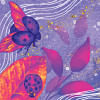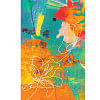Emily Dickinson: A prodigy prosodist of Modern literature

In the year of 1858, on a desolate evening, Emily Dickinson penned down the following poem,
"I never lost as much but twice,
And that was in the sod.
Twice have I stood a beggar
Before the door of God!
Angles-Twice descending
Reimbursed my store-
Burglar! banker - Father!
I am poor once more!"
It's undoubtedly an enigmatic poem, pregnant with ideas that are there but not vividly apparent. But I won't focus on the meaning here. Instead, I would like to request you to read the poem. Read it out loud if possible. In case you didn't consciously notice, the poem sounded like a song in your head and it had a satisfying ring to it. It doesn't happen for no reason. There is a detailed mechanism behind it.
First of all, the entire first stanza here is in the common meter, except for the third catalectic line. While these four lines maintain the consistent pattern of eight and six syllables, the third line uses seven syllables instead of eight. This can seem like a flaw but it actually serves a purpose. The inconsistency here breaks the monotony of regularity, giving a unique taste to the poem.
Through this kind of unorthodox techniques, Dickinson shows that consistent rhymes, correct grammar, and regular rhythm are not essential components of good poetry. The mellifluousness of language, no matter how it comes, is what gives a heightened attribute to the essence of a poesy.
However, not everyone can get out of the traditional style and create something excruciatingly melodious. Metrical irregularity doesn't always equate to musical poetry. John Donne implemented such styles in his poems way before Dickinson. But his irregularity was not as appreciated as Dickinson's was. In fact, Ben Johnson disapproved of it. In a conversation with William Drummond, Ben Johnson commented,
In contrast, Dickinson takes the approach that gives her poem a musical value. Her poems contain fewer syllables and the difference in the number of meters is narrower than that of Donne. Dickinson either uses 7 syllables instead of 8, or 4 syllables instead of 6.
"Donne, for not keeping of accent, deserved Hanging."
Why such a vulgar remark? Well, in my opinion, Donne failed to give a significance to metrical irregularity. In other words, the missing meters didn't add any musical value to the verses. This is why his poem doesn't sound as pleasing as Dickinson's.
Take "The Sun Rising" for example. It reads,
"Busy old fool, unruly sun,
Why dost thou thus,
Through windows, and through curtains call on us?
Must to thy motions lovers' seasons run?
Saucy pedantic wretch, go chide
Late school boys and sour prentices,
Go tell court huntsmen that the king will ride,
Call country ants to harvest offices,"
Despite being a great poem, this clearly doesn't feel as harmonious as the first one. Why? Donne too here has maintained a metrical irregularity like Dickinson did. But there are a few reasons why one sounds lovely while the other one not so much.
First of all, Donne uses too many syllables in a line. The verses take longer to read and, as a result, the effect of rhymes fades out before it reaches the rhyming word. In addition, the difference between the number of meters is pretty wide too. Here, Donne puts four syllables instead of eight.
In contrast, Dickinson takes the approach that gives her poem a musical value. Her poems contain fewer syllables and the difference in the number of meters is narrower than that of Donne. Dickinson either uses 7 syllables instead of 8, or 4 syllables instead of 6. This small difference makes the inconsistency not so noticeable, yet its' sound perfectly breaks the monotony of metric regularity.
The similar effect of metrical irregularity in Dickinson can be found in "This Is My Letter to The World". This poem too contains a catalectic line in the 2nd stanza. The missing metric foot here automatically pauses the reader's voice, breaking the consistency. If there was a single more syllable, the pattern of regularity would've been maintained, making the poem sound a bit dull.
Nevertheless, fiddling with rhythmic structure is not the only point that labels her as a genius. There are a few more things that make her poetry engaging and give the reader a profound experience. One example of such traits can be her choice of simple words and their placement in unfamiliar phrases. Surprisingly, this arrangement creates unique, yet realistic pictures that are appealing to both the ear and mind. The common words here don't force the imagination to picture a vision. Rather, it happens spontaneously. As a result of this, the presentation here connotes simple, regular ideas in fluent, concise words. Readers, at the same time, understand the picture and experiences delight reading it.
For instance, Dickinson describes clouds (or probably sky?) as "pile of wind" in "High From The Earth I Heard A Bird". Similarly, he mentioned volcanoes as "phlegmatic mountains" in "I Have Never Seen 'Volcanoes'". Dickinson commonly does this in her poems to make it easy for the reader to imagine the intended sentiment.
The common words here don't force the imagination to picture a vision. Rather, it happens spontaneously. As a result of this, the presentation here connotes simple, regular ideas in fluent, concise words. Readers, at the same time, understand the picture and experience delight reading it.
Probably the most amazing thing about Dickinson's poetry is her inimitable usage of dashes (-). If you examine the original manuscript of the poems, (or the printed versions that preserved the original style), you will notice a plethora of dashes scattered here and there. At first, it may strike as unnatural, or as mistakes. But actually, they have specific values. It gives her poem a unique vocal dimension.
Let's explore this idea through some examples. The poem "I Tie My Hat- I Crease My Shawl" has 48 dashes. Grammatically speaking, this punctuation mark suggests pause. But here, they also work as the tool that reflects Dickinson's inner voice, of her own emotion. The dashes here do indeed mean pause. And it is the pausing that gives her poem a different taste.
The number of pauses here can be read as panting of a breathless voice. If you read the following lines while maintaining the pauses of the dashes, it will create such effect of a gasping sound.
"I have so much to do—
And yet—Existence—some way back—
Stopped—struck—my ticking—through—
We cannot put Ourself away"
This effect can also be considered as the anxious voice of an agoraphobic person. It's a rational conclusion considering that Dickinson was diagnosed with agoraphobia. In this sense, through the dashes here, Dickinson actually manifested her feelings.
However, the dashes can have different connotations too. For example, "Wild Nights, - Wild Nights" only has 9 dashes. The dashes here suggest a calm tone. Here, the distance between two dashes gives a serious, grave voice to the collection of verse. In both cases, reading the poem utilizing the dashes gives it a musical touch.
It's noteworthy that Dickinson sometimes used dash instead of full stops. This can be seen in, "There's A Certain Slant of Light", "The Soul Selects Her Own Society", "We Do Not Play on Graves", "I Felt A Funeral, In My Brain", and in many more of his popular poems.
All these poems end with dashes instead of period. Thus, these concluding lines are marked by incompleteness. While full stop is the pause that determines the end of a sentence, dash means a pause that indicates there is more to the sentence. In other words, the dash means the thought isn't complete.
Here, too, using dash is Dickinson's way of communicating. Putting dash as the concluding punctuation means she still has more to say but she's either choosing not to say it, or can't find the ideal voice to express the intended emotion.
Dickinson's usage of punctuation as a significant device of poetry makes her works seem more and more interesting to me.
She plays with rhyming as well. The unique patterns of rhyme schemes give a different flavor to her verses. It has been already mentioned how Dickinson breaks the metrical regularity. Just like the meters, the poet uses inconsistent rhyming too. Many of her poems contain eye rhymes and slant rhymes.
"Success Is Counted Sweetest" has eye rhymes in it. The poem goes,
"Who took the flag today
………………………
So clear of Victory"
Here the words "today" and "Victory" end with the same letter "y" but not with the same "y" sound. In other words, it seems like they would rhyme, but they don't. This is an example of eye rhyme.
Slant rhyme is the rhyme scheme where words have similar, but not identical sound. For example, two lines from "Not Any Higher Stands the Grave", reads,
"The beggar and his Queen
……………………….
A Summer's Afternoon"
Here, the words "Queen" and "Afternoon" end with the "n" sound. But, due to the vowel that comes before, the pronunciation of this "n" slightly changes. In other words, they only partially rhyme.
Dickinson often implemented these types of rhyme schemes to give the poem a sense of discomfort, complimenting the sentiment of the poem. However, she usually ends her poem with perfectly metered full rhyme. "I Have Never Lost as Much but Twice", not only concludes with full rhyme, the final verse has internal rhymes as well.
Dickinson deploys such rhyme structure to build up an uneasy, and discomfort feeling in the reader. Toward the end, she provides a satisfying closure with full rhymes to numb the uncomfortable sense the poem has been developing in the previous lines.
It is apparent in her poem how she channeled her phobia, trauma, and depression through artistic endeavor. While readers can consciously understand her emotion by the dictions, it is her style of writing, the dashes, unusual rhymes, unique phrases, and metrical irregularity that enables her poems to subtly affect the reader's sub-conscious and makes the reader feel what she experienced. This is the prominent reason why her style is so significant.
As the essence of her poems silently slides into the reader's cognition, its effect remains dormant yet active in the mind. Sometimes, Miss Dickinson's poems are enigmatic, but her messages never fail to reach our senses. The credit here goes to her poetic mastery. It has been a topic of debate whether Miss Dickinson deliberately or spontaneously made these delicate choices while writing her poetry. There are interesting arguments supporting both these contrasting claims. Either way, it only shows how marvelous and brilliant Emily Dickinson was.
Abdullah Rayhan is studying English Literature at Jahangirnagar University.

 For all latest news, follow The Daily Star's Google News channel.
For all latest news, follow The Daily Star's Google News channel. 








Comments